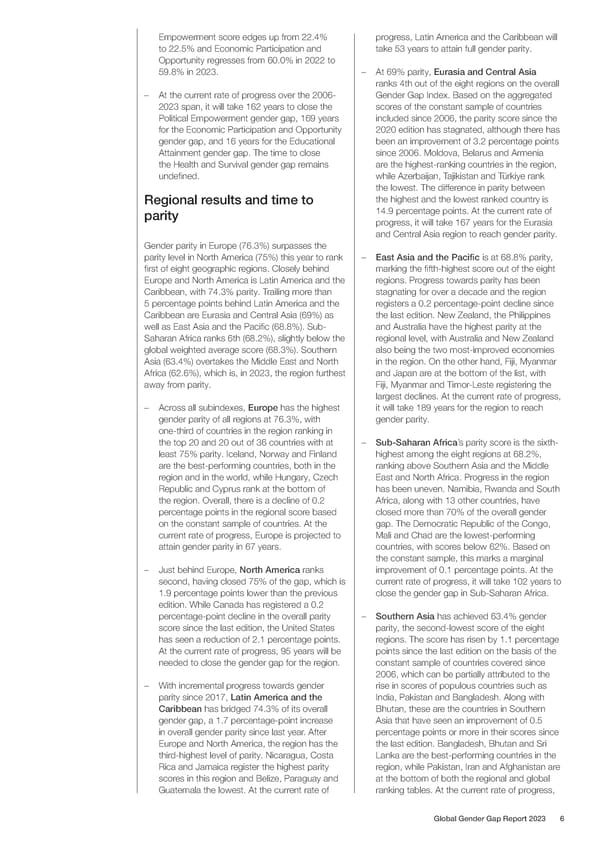Empowerment score edges up from 22.4% progress, Latin America and the Caribbean will to 22.5% and Economic Participation and take 53 years to attain full gender parity. Opportunity regresses from 60.0% in 2022 to 59.8% in 2023. – At 69% parity, Eurasia and Central Asia ranks 4th out of the eight regions on the overall – At the current rate of progress over the 2006- Gender Gap Index. Based on the aggregated 2023 span, it will take 162 years to close the scores of the constant sample of countries Political Empowerment gender gap, 169 years included since 2006, the parity score since the for the Economic Participation and Opportunity 2020 edition has stagnated, although there has gender gap, and 16 years for the Educational been an improvement of 3.2 percentage points Attainment gender gap. The time to close since 2006. Moldova, Belarus and Armenia the Health and Survival gender gap remains are the highest-ranking countries in the region, unde昀椀ned. while Azerbaijan, Tajikistan and Türkiye rank the lowest. The difference in parity between Regional results and time to the highest and the lowest ranked country is parity 14.9 percentage points. At the current rate of progress, it will take 167 years for the Eurasia and Central Asia region to reach gender parity. Gender parity in Europe (76.3%) surpasses the parity level in North America (75%) this year to rank – East Asia and the Paci昀椀c is at 68.8% parity, 昀椀rst of eight geographic regions. Closely behind marking the 昀椀fth-highest score out of the eight Europe and North America is Latin America and the regions. Progress towards parity has been Caribbean, with 74.3% parity. Trailing more than stagnating for over a decade and the region 5 percentage points behind Latin America and the registers a 0.2 percentage-point decline since Caribbean are Eurasia and Central Asia (69%) as the last edition. New Zealand, the Philippines well as East Asia and the Paci昀椀c (68.8%). Sub- and Australia have the highest parity at the Saharan Africa ranks 6th (68.2%), slightly below the regional level, with Australia and New Zealand global weighted average score (68.3%). Southern also being the two most-improved economies Asia (63.4%) overtakes the Middle East and North in the region. On the other hand, Fiji, Myanmar Africa (62.6%), which is, in 2023, the region furthest and Japan are at the bottom of the list, with away from parity. Fiji, Myanmar and Timor-Leste registering the largest declines. At the current rate of progress, – Across all subindexes, Europe has the highest it will take 189 years for the region to reach gender parity of all regions at 76.3%, with gender parity. one-third of countries in the region ranking in the top 20 and 20 out of 36 countries with at – Sub-Saharan Africa’s parity score is the sixth- least 75% parity. Iceland, Norway and Finland highest among the eight regions at 68.2%, are the best-performing countries, both in the ranking above Southern Asia and the Middle region and in the world, while Hungary, Czech East and North Africa. Progress in the region Republic and Cyprus rank at the bottom of has been uneven. Namibia, Rwanda and South the region. Overall, there is a decline of 0.2 Africa, along with 13 other countries, have percentage points in the regional score based closed more than 70% of the overall gender on the constant sample of countries. At the gap. The Democratic Republic of the Congo, current rate of progress, Europe is projected to Mali and Chad are the lowest-performing attain gender parity in 67 years. countries, with scores below 62%. Based on the constant sample, this marks a marginal – Just behind Europe, North America ranks improvement of 0.1 percentage points. At the second, having closed 75% of the gap, which is current rate of progress, it will take 102 years to 1.9 percentage points lower than the previous close the gender gap in Sub-Saharan Africa. edition. While Canada has registered a 0.2 percentage-point decline in the overall parity – Southern Asia has achieved 63.4% gender score since the last edition, the United States parity, the second-lowest score of the eight has seen a reduction of 2.1 percentage points. regions. The score has risen by 1.1 percentage At the current rate of progress, 95 years will be points since the last edition on the basis of the needed to close the gender gap for the region. constant sample of countries covered since 2006, which can be partially attributed to the – With incremental progress towards gender rise in scores of populous countries such as parity since 2017, Latin America and the India, Pakistan and Bangladesh. Along with Caribbean has bridged 74.3% of its overall Bhutan, these are the countries in Southern gender gap, a 1.7 percentage-point increase Asia that have seen an improvement of 0.5 in overall gender parity since last year. After percentage points or more in their scores since Europe and North America, the region has the the last edition. Bangladesh, Bhutan and Sri third-highest level of parity. Nicaragua, Costa Lanka are the best-performing countries in the Rica and Jamaica register the highest parity region, while Pakistan, Iran and Afghanistan are scores in this region and Belize, Paraguay and at the bottom of both the regional and global Guatemala the lowest. At the current rate of ranking tables. At the current rate of progress, Global Gender Gap Report 2023 6
 Global Gender Gap Report 2023 Page 5 Page 7
Global Gender Gap Report 2023 Page 5 Page 7